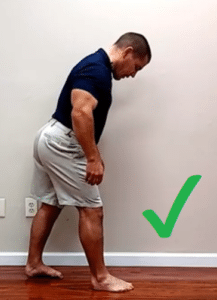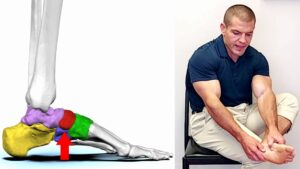Do You Get Foot Arch Pain When Walking?
If you get foot arch pain walking, it's very likely that you've either been diagnosed with plantar fasciitis. Or, you may have been reading on the internet and think you have plantar fasciitis.
However, there are many other things that can cause foot arch pain when walking, and getting hung up on the diagnosis of plantar fasciitis can actually stop you from getting better.
Watch this video to learn what causes foot arch pain walking, a more importantly, how you can relieve your pain so that you can longer without pain and and discomfort.

What Causes Arch Pain Walking?
There are several structures in the bottom of your foot:
- Your foot bones and joints
- Four different layers of muscles
- Nerves, arteries, and veins
- The planta fascia
So to think that plantar fasciitis is the only thing that can cause foot arch pain when walking is a massive oversimplification.
Furthermore, it's rather rare that people have true plantar fasciitis.
In fact, plantar fasciitis itself is rarely an "itis," meaning it's not inflammatory.
The plantar fascia is the superficial covering on the bottom of the foot.
Beneath that, there are the four layers of foot muscles.
Entwined in those layers is the medial plantar nerve.
Ultimately, all foot arch pain has something to do with the medial and/or lateral plantar nerve because that's what sends the signal from your foot to your spinal cord to your brain so that you're aware that there's a problem.
Often though, just stepping on that nerve over and over when you're walking can get those nerves irritated.
Therefore, the medial/lateral plantar nerve itself can become a source of arch pain.
But even when it's not, the muscles on the bottom of the foot can become a source of the pain as well.
So how do you stop the muscles and the nerves in your foot from hurting while you walk?
How To Fix Arch Pain Walking
1. Prevent Overpronation
One of the most common causes of plantar fasciitis and other types of foot arch pain is what's known as overpronation. This means that your foot flattens out too much when you're walking.
When your foot flattens out, the plantar fascia stretches out on the bottom of the foot and brings the arch closer to the ground. This compresses and puts pressure on the muscles of the inside part of the foot, particularly the abductor hallucis and flexor hallucis brevis.
The medial plantar nerve travels between abductor hallucis and flexor hallucis brevis. As a result, it can also cause get compressed from overpronation.
An easy way to stop foot arch pain when walking is to not allow that overpronation to happen. You can stop the overpronation by gripping the ground with your toes to actively lift your arch up and activate those deep muscles on the inside of the foot.
By lifting the arch up and activating those four layers of muscles on the inside of the foot, it prevents your foot from flattening down on all the structures and decreases the foot arch pain when you walk.
2. Stretch Your Calves
The arch also collapses down when your calves are too stiff when taking a step. As a result, stretching your calves is another really important thing if you have foot pain.
When most people stretch their calf, they allow their foot to slightly turn out to the side and flatten the arch.
By doing so, they're actually overpronating when stretching their calves.
It's very important to stretch your calves properly. Make sure to keep the toes pointed straight with the arch lifted up.
Then stretch the calf to your tolerance while keeping the knee straight and heel down on the ground without allowing the arch to flatten or without allowing the toes to turn out.
Make sure to only stretch to your tolerance without overstretching the calf.
Often the "burn" sensation that you feel when you're stretching is actually the overstretching of the nerves.
Don't Overstretch!
Your Foot Joints Can Cause Arch Pain Walking
Your foot is not one solid structure, but it is composed of several joints. The foot and ankle are made of several little bones as well as the long bones of your toes, including the metatarsals.
Within the midfoot, the navicular or the cuneiforms may push down, "squirt out," and put pressure against the nerves, muscles, and the plantar fascia when you overpronate your foot.
BodyParts3D is made by DBCLS, CC BY-SA 2.1 JP, via Wikimedia Commons
Regardless of which of the structures is causing the problem, if you don't overpronate and don't let those bones "squirt out", then it's going to help prevent your symptoms.
But what do you do if the bone has already squirted out?
3. Mobilizing Your Foot Bones
There are some simple stretches that you can do to help get those bones in the middle of your foot moving correctly.
For one of the stretches, you'll sit down in a chair and cross the sore foot over the other knee.
Then find a spot along the bottom of your arch here where it sticks out.
Take your thumb and place it directly over that bone.
With the other hand, you put your thumb right next to the other thumb and wrap your fingers around the top of the foot.
This places the fingers together on the top of the foot and the thumbs together on the bottom of the foot.
The thumb that's closest to your ankle will be pushing on the bone that sticks out.
Then take the hand that's wrapped around your forefoot and pull it toward the sole of the foot.
4. Strengthen The Foot Muscles
While maintaining the hand pressures on the foot, activate your arch muscles by scrunching your toes slightly.
Hold the position and the muscle contraction for about 5 seconds and then relax. Repeat that for 10-20 repetitions.
This will help strengthen your foot muscles.
Then stand back up and practice doming the arch in a standing position.
When walking, only take steps that are long enough where you can maintain the shortened and domed arch position.
How often should you practice keeping the arch lifted while walking?
Ideally, anytime you walk.
That can be difficult, especially if those muscles have gotten deconditioned, and you've been walking with a flat foot for a number of years.
5. Use Orthotics or Arch Supports
If it's difficult to constantly bring the arch up, using custom orthotics or over-the-counter arch supports might help decrease the pain and hold those bones up in place.
Superfeet All-Purpose Support High Arch ...
Should you still activate the arch muscles in your foot if you wear orthotics?
You should still activate your foot muscles even if you wear orthotics
The orthotics or the arch supports give you a little bit of extra support to assist your foot muscles.
However, if you don't activate your foot muscles then you'll become dependent on the orthotics and may have arch pain when walking barefoot.
Conclusion
Hopefully you found this helpful if you're having arch pain when walking.
In summary, here are the tips to relieve foot arch pain walking:
- Doming your arch
- Stretching your calves CORRECTLY
- Mobilizing foot bones
- Foot muscle strengthening
- Use orthotics or arch supports
If you live in the St. Louis area and need more help for foot pain, we'd be happy to help you here at More for Life.
Just tap the button below to request an appointment with one of our specialist physical therapists.
Like this post? Check out some of our other posts about foot pain and plantar fasciitis.
When Is Foot Arch Pain Not Plantar Fasciitis?
How To Relieve Pain In Foot In The Morning














